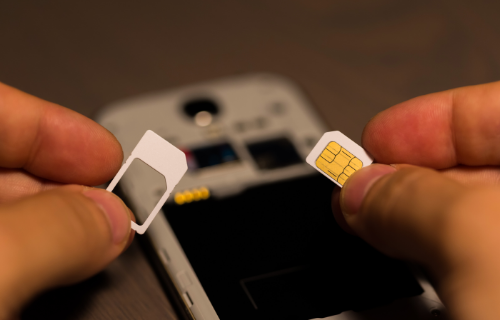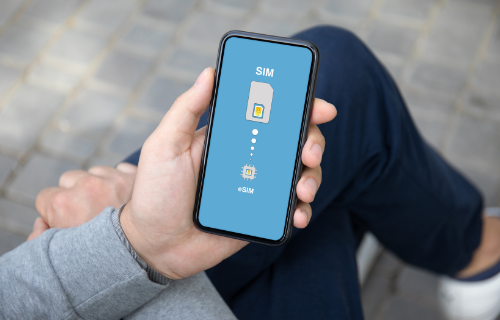Difference Between eSIM and Physical SIM
Today, many companies are turning to more advanced eSIM instead of a physical SIM card. Well, everybody is familiar with the SIM card that you have to insert into your mobile device to enjoy wireless service. SIM, an acronym for Subscriber Identity Module, is a tiny, portable chip that holds unique information used to identify a cell phone to a mobile phone network. But things are changing now. eSIM has become a new standard of mobile connectivity. Let’s see how an eSIM works and is it any better than the physical SIM you’re already using.

What is a Physical SIM?
SIM, short for Subscriber Identity Module, is a thumbnail sized tiny chip that goes into your cell phone and stores unique information to connect a mobile phone to a specific mobile network. That tiny little SIM holds a lot of data including your identity, phone number, contact lists, texts, location data, and lot more. SIM cards were the size of postage stamps when they started out, but have gotten smaller over the years as cell phone manufacturers reclaim more space for other features. Basically, a SIM card is the heart of your phone.
Well, everything you do on your phone is because of the SIM card. It allows you to do everything, from making calls to sending text messages, connecting to internet services like 3G, 4G, and 5G. SIM cards can also be used satellite phones, computers, cameras, smart watches, or tablets. SIM cards come in three basic size options: the standard, the micro, and the nano. Manufacturers have come up with a new type of embedded chip for mobile phones called an eSIM, which would allow you to switch carriers easily.

What is an eSIM?
An eSIM, or an embedded SIM or electronic SIM is a new standard for the mobile connectivity that is a worthy substitute for a physical SIM card. SIM cards have evolved from full-sized SIMs in 1991 to the more advanced and insanely small eSIM cards. They were first introduced in 2012 and have the same functionality as the traditional SIM cards. An eSIM, as the name suggests, is a programmable SIM embedded directly inside your phone right from the manufacturing process. It is permanently surface mounted to the mobile device straight out of the box.
The eSIM is not installed in the mobile terminal by the network operator but by the manufacturer. There is no physical SIM card involved and no swapping required either. The eSIM is in fact a perfect substitute for an actual physical SIM card that makes it easier to switch carriers on the same phone so that you can connect to any mobile operator that offers eSIM services. It basically works the same way as a physical SIM card, but without the need of inserting a physical SIM card into the slot.
Difference between eSIM and Physical SIM
Form Factor
– SIM cards are classified by their form factors by subscriber identity modules as 1FF, 2FF, 3FF, 4FF, and MF2. Each generation of the SIM card is smaller than the last generation. 2FF refers to mini SIMs, 3FF is for micro SIMs, and 4FF goes for nano SIMs. So, physical SIM cards come under the following form factor. The eSIM is an embedded SIM that is classified under a commonly designated MFF2, which stands for machine-to-machine form factor.
Chip
– Unlike a traditional SIM that goes into the SIM tray inside your phone, an eSIM is an electronic form of the traditional SIM card that is embedded directly onto the device’s motherboard right from the manufacturing process. It doesn’t require any physical card and it is permanently surface mounted to the mobile device straight out of the box. It basically works the same way as a physical SIM card, but without the need of inserting a physical SIM card into the slot.
Network Switching
– Unlike a regular SIM card, an eSIM doesn’t require a physical card and it can be linked to several network operators. It basically removes the existing connection between the network operator and the customer, making it easier to switch carriers on the same phone. An eSIM is built into the phone itself via software, with your coverage purchased via mobile networks.
SIM Profile
– An eSIM can store up to five virtual SIM cards, so you can easily switch between carriers if you find yourself in an area with a bad coverage. A regular physical SIM card holds one profile per customer whereas an eSIM holds multiple profiles for the customer, which is a major advantage. An eSIM is only a reprogrammable logical profile on your smartphone. Also, an eSIM allows you to manage your SIM profile on other devices like smart watches, computer, cars, and so on. With the same eSIM profile, you can program it to work on multiple devices.
eSIM vs. Physical SIM: Comparison Chart

Summary
To get a physical SIM card, you need to go and physically buy a plastic SIM card that links with a network and only works with only one device. An eSIM is not a separate piece, but rather a part of the device that is directly surface mounted onto the device as a chip and supports remote provisioning of credentials. Unlike a traditional SIM, an eSIM can store multiple profiles and the information is rewritable, which means you can switch networks without worrying about removing your SIM and inserting a new one.
Is eSIM better than physical SIM?
Technically, an eSIM makes it much easier to switch carriers without the need to remove SIM cards and insert a new one. It is just a chip embedded directly inside your phone and supports multiple profiles.
What is the disadvantage of eSIM?
You need to download your SIM profile from the cloud, which is considerably more time consuming. It’s not as easy to quickly switch devices. An eSIM cannot be removed from the device either, which can be viewed both as an advantage and a disadvantage.
Can a physical SIM be used as an eSIM?
No. You cannot have a physical SIM and an eSIM for the same number. A physical SIM cannot be used as an eSIM either because the eSIM is soldered into the device itself and cannot be physically pulled out or swapped like a regular SIM.
- Difference Between Caucus and Primary - June 18, 2024
- Difference Between PPO and POS - May 30, 2024
- Difference Between RFID and NFC - May 28, 2024
Search DifferenceBetween.net :
Leave a Response
References :
[0]Battu, Daniel. Communication Networks Economy. New Jersey, United States: John Wiley & Sons, 2016. Print
[1]Hart-Davis, Guy. Teach Yourself VISUALLY iPhone 11, 11Pro, and 11 Pro Max. New Jersey, United States: John Wiley & Sons, 2020. Print
[2]Liu, Qi, et al. Proceedings of the 9th International Conference on Computer Engineering and Networks. Singapore: Springer Nature, 2020. Print
[3]Fallgren, Mikael, et al. Cellular V2X for Connected Automated Driving. New Jersey, United States: John Wiley & Sons, 2021. Print
